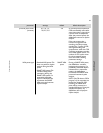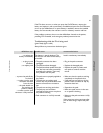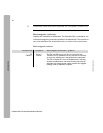
51
Philips Medical Systems
APPENDICES
Electromagnetic immunity
immunity test IEC 60601
test level
compliance
level
electromagnetic environment - guidance
electrostatic discharge
(ESD)
IEC 61000-4-2
± 6 kV contact
± 8 kV air
± 6 kV contact
± 8 kV air
There are no special requirements with
respect to electrostatic discharge.
a
power frequency
(50/60 Hz) magnetic field
IEC 61000-4-8
3 A/m 3 A/m Power frequency magnetic fields should
be at levels characteristic of a typical
location in a typical commercial/hospital
environment.
There are no special requirements for
non-commercial/non-hospital
environments.
radiated RF
IEC 61000-4-3
10 V/m
80 MHz to 2.5
GHz
[E1] V/m Portable and mobile RF communications
equipment should be used no closer to
any part of the HeartStart FRx, including
cables, than is absolutely necessary.
b,c
The recommended separation distances
for various transmitters and the AED
are shown in the following table.
Interference may occur in the
vicinity of equipment marked
with the following symbol:
NOTE 1.At 80 MHz and 800 MHz, the higher frequency range applies.
NOTE 2.These guidelines may not apply in all situations. Electromagnetic propagation is affected by absorption and reflection from
structures, objects and people.
a. Generally, AEDs are sometimes susceptible to interference generated by patient and/or responder motion in environments in which a high
static electric field is present (e.g., low humidity, synthetic carpets, etc.). As a safety measure, Philips AEDs incorporate a patented method
to sense possible corruption of the ECG signal by such interference and to respond by directing the user to stop all motion. In these cases,
it is important to minimize movement in the vicinity of the patient during rhythm analysis in order to ensure that the signal being analyzed
accurately reflects the patient’s underlying heart rhythm.
b. The ISM (industrial, scientific and medical) bands between 150 kHz and 80 MHz are 6,765 MHz to 6,795 MHz; 13,553 MHz to 13, 567 MHz;
26,957 MHz to 27,283 MHz; and 40,66 MHz to 40,70 MHz.
c. Field strengths from fixed transmitters, such as base stations for radio (cellular/cordless) telephones and land mobile radios, amateur radio,
AM and FM radio broadcast, and TV broadcast cannot be predicted theoretically with accuracy. To assess the electromagnetic environment
due to fixed RF transmitters, an electromagnetic site survey should be considered. If the measured field strength in the location in which
the HeartStart FRx is used exceeds the applicable RF compliance level above, the HeartStart FRx should be observed to verify normal
operation. If abnormal performance is observed, additional measures may be necessary, such as re-orienting or relocating the HeartStart.


















